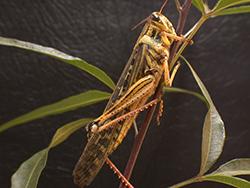As a kid, Scott Kirkton never played with bugs (his mother did his insect collection in elementary school). But times change - Kirkton now plays with grasshoppers a lot. A recent study he conducted, in part at Argonne National Laboratory, offers insight into the relationship between respiratory function and molting.
"With each molt, grasshoppers shed their exoskeletons and emerge into new ones that provide room for growth," Kirkton explained. "During the six stages of their lifecycle, they get progressively larger."
This means that grasshoppers’ insides are essentially too big for their outsides near the end of each stage, and organs for breathing (air sacs and tracheae) might get compressed.
"These grasshoppers, Schistocerca americana, emerge as 10-milligram juveniles and become 2.5-gram adults in about six weeks. That's a 250-fold weight increase,” Kirkton said. "It's equivalent to an 8-pound baby being 2,000 pounds after six weeks.
"We propose that if late-stage grasshoppers have trouble breathing and oxygen delivery is reduced, molting might occur to increase exoskeleton size and alleviate respiratory system compression."


